Saint Mary's Newsroom / Campus Notes
Winona Campus Newsletter
Celebrating a 300-year Lasallian heritage
Saint Mary’s University joins Lasallians across the globe in celebration of the 300th anniversary of the death of Saint John Baptist de La Salle, the patron saint of educators and founder of the De La Salle Christian Brothers.
The Holy See declared 2019 a jubilee year in honor of De La Salle and his life’s work of making a quality and relevant education accessible to all students, especially the poor.
In addition to recognizing the anniversary of De La Salle’s death, the jubilee celebrates the impact of the mission he started. The Lasallian mission is present in 80 countries around the world, with between 3,500 and 4,000 De La Salle Christian Brothers and 90,000 Lasallian Partners serving 1 million young people in 1,000 educational ministries. Saint Mary’s University — as one of 65 Lasallian higher education institutions — is one small portion of a global Lasallian network of dedicated educators.
Today, Brothers and Lasallian partners work together and by association to create communities that demonstrate diversity, human dignity, and virtue and that provide transformative experiences that are innovative and holistic.
A Mass to commemorate the 300th anniversary will be held Saturday, Nov. 16, at 4 p.m., celebrated by Father President James P. Burns, IVD, Ph.D., in Saint Thomas More Chapel on the Winona Campus. A reception will follow at 5 p.m.
Additionally, a number of events have been planned in celebration of our heritage.
Ignite 300 grants
Saint Mary’s University, in honor of the 300-year anniversary, has announced recipients of the Ignite 300 Mini Grant Program. The Ignite 300 Mini Grant Program encourages innovative research within our community by incorporating an appreciation for the Twelve Virtues of a Good Teacher. These mini grants are designed to assist faculty in conducting original research that may be pilot in nature or to further a strand of current research efforts.
Other events
- In October, as part of our annual Lasallian Day of Service, 70 students here at the College completed service projects in about 30 locations, and about 125 alumni volunteered at sites in Winona, Rochester, and the Twin Cities, as well as Chicago, Milwaukee, Phoenix, and New York.
- In early November, Saint Mary’s undergraduate students sent personalized thank-you letters to grade school teachers who have influenced their lives. We celebrate all educators who are providing a caring and transformational experience to the students they teach, just as De La Salle once did.
- Students have enjoyed a movie about Saint John Baptist de La Salle’s life, a medallion hunt, and a Lasallian talent contest.
- The Saint Mary’s community was invited to submit Lasallian essays reflecting on “What does it mean to be at a Lasallian Catholic University.”

Saint Mary’s students pay to give up cell phones for a good cause
In honor of Blessed Brother James Miller, FSC, a Saint Mary’s University alumnus, undergraduate students are making the “ultimate sacrifice,” relinquishing their cell phones for one day, Nov. 25.
Brother James Miller, who earned his graduate and undergraduate degrees from Saint Mary’s in 1966 and 1974, was only 37 when he was shot and killed as he was mending a wall outside a school where he worked in Huehuetenango, Guatemala, in 1982. It is suspected that Brother James was killed because he and the other Brothers fought to keep their young students from being forced into the military.
Pope Francis  recognized the martyrdom of Brother James in 2018. Brother James will be the first De La Salle Christian Brother from the United States to be beatified. The date of his beatification ceremony will be Dec. 7, 2019, in Huehuetenango. Beatification brings him one step closer to sainthood.
recognized the martyrdom of Brother James in 2018. Brother James will be the first De La Salle Christian Brother from the United States to be beatified. The date of his beatification ceremony will be Dec. 7, 2019, in Huehuetenango. Beatification brings him one step closer to sainthood.
Participating students are asked to also donate $2. Funds raised during “No Cell Phone Day” Nov. 25 will be used for scholarships for Guatemalan students at Casa Hermano Santiago Miller, the school where Brother James worked that now bears his name. More than 75 percent of the population in Guatemala lives below the poverty line.
Participating students’ cell phones will be on display in the Toner Student Center, along with their names. Money raised will be presented in person during Brother James’ beatification ceremony.
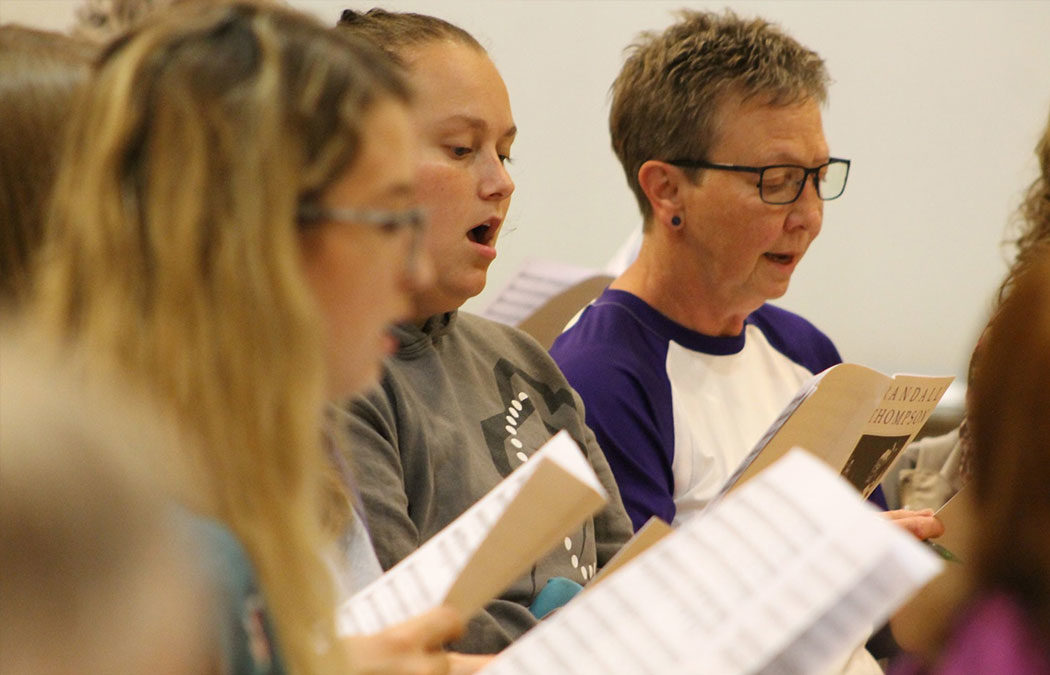
Public invited to Valéncia Chorale debut concert
WINONA, Minn. — The community is invited to the inaugural Valéncia Chorale concert on Thursday, Nov. 21, at 7 p.m. in the Chapel of Saint Mary of the Angels, 1155 W. Wabasha St. Comprised of singers from the Winona area, the Valéncia Chorale is a mixed community choir directed by Dr. Patrick O’Shea. They explore music of a wide range of periods and genres.
Since the Valéncia Chorale was formed in September, more than 40 adults of all ages have been gathering weekly to join in song and enjoy the social, emotional, and musical benefits of preparing for their debut concert.
The audience will enjoy familiar and new pieces, including Randall Thompson’s “From Frostiana,” which adapts Robert Frost’s poems in beautiful choral arrangements; old American songs by Aaron Copland; and Scottish folk songs.
Tickets will go on sale Thursday, Nov. 14, and are $10 for adults and $5 for students. They can be purchased at the Valéncia Arts Center, 1164 W. 10th St., or one hour prior to the performance at Chapel of Saint Mary of the Angels. Cash or check only. Handicapped seating is available. For more information, call 507-453-5500 or email mca@smumn.edu.
About MCA
The Minnesota Conservatory for the Arts (MCA), an affiliate program of Saint Mary’s University of Minnesota, is a nonprofit community arts school offering programming in dance, music, visual art, and theater. Classes, lessons, workshops, and camps are offered for students of all ages from birth through older adults at the Valéncia Arts Center. For more information about MCA or Galleria Valéncia, visit mca.smumn.edu, email mca@smumn.edu, or call 507-453-5500.

MCA hosts printmaking exhibit
WINONA, Minn. — Minnesota Conservatory for the Arts (MCA) invites the community to view a unique exhibit, featuring the work of printmaking artists ages 55 and older who participated in a recent workshop alongside teens from Riverway Learning Community.
The exhibit opening will kick off with an open house event on Tuesday, Nov. 19, from 4:30 to 6 p.m. at the Valéncia Arts Center, 1164 W. Howard St., where guests can meet and greet the artists and view projects created during the generational printmaking class.
Class participants were invited to explore a variety of printmaking techniques through group and individual instruction under the direction of local teaching artist, Brianna Haupt, thanks to a generous grant from Aroha Philanthropies.
The exhibit will be on display Tuesday, Nov. 19, through Thursday, Dec. 19. Guests can visit at no cost during regular business hours: Mondays and Tuesdays, 9 a.m. to 7 p.m.; Wednesdays, 11:30 a.m. to 5:30 p.m.; Thursdays and Fridays, 9 a.m. to 3 p.m.; and Saturdays, 9 a.m. to noon.
About Vitality Arts
The broad field of creative aging encompasses many things: arts education, arts in health care, creativity for those with dementia, and more. Arts education programs — those that inspire and enable older adults to learn, make and share the arts in ways that are novel, complex and socially engaging — make up a subset of the creative aging field. Often referred to as artful aging programs, they are led by teaching artists whose creative process and understanding of older adults bring connection, improved health and well-being, and a renewed sense of purpose to older adults in community and residential settings.
At Aroha Philanthropies, we’ve come to view these programs as even more than artful aging. With the term “vitality arts,” we aim to champion arts programs that keep us vital, joyful, and engaged by unleashing the transformative power of creativity in those 55 and older. More information is available at vitalityarts.org.
About Aroha Philanthropies
Aroha Philanthropies is devoted to the transformative power of the arts and creativity, inspiring vitality in those over 55, joy in children and youth, and humanity in adults with mental illness. We believe that learning, making, and sharing art enriches everyone throughout their lifetime. Aroha Philanthropies works to improve the quality of life of people 55 and older by encouraging the funding, development, and proliferation of arts programs designed to enhance longer lives, and by advancing the development of professional teaching artists working with those in their encore years. More information is available at arohaphilanthropies.org.
About MCA
The Minnesota Conservatory for the Arts (MCA), an affiliate program of Saint Mary’s University of Minnesota, is a nonprofit community arts school offering programming in dance, music, visual art, and theater. Classes, lessons, workshops, and camps are offered for students of all ages from birth through older adults at the Valéncia Arts Center. For more information about MCA or Galleria Valéncia, visit mca.smumn.edu, email mca@smumn.edu, or call 507-453-5500.
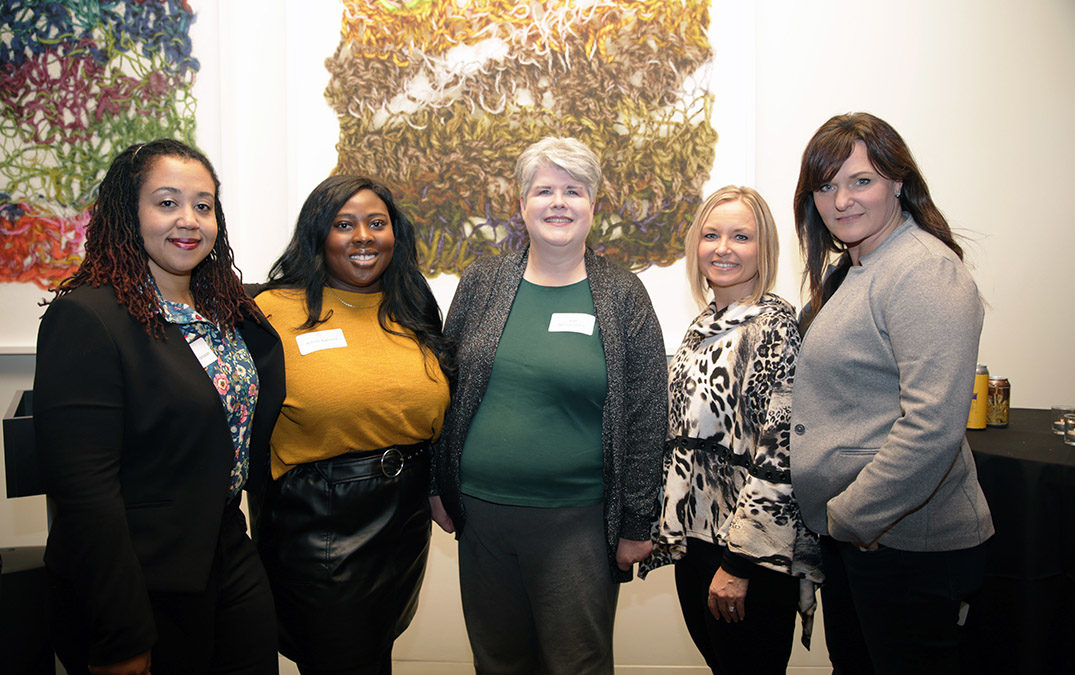
Inaugural reception provides community-building experience, connections for online graduate students
Looking around the reception area at the American Swedish Institute (ASI), Kim Hatley had a lot to take in, following her flight east.
On the night of Oct. 11, the resident of Spokane, Wash., had just flown into the Twin Cities for the first time, dropped her bags off at her hotel room, and stood face-to-face with four fellow classmates from four other states who, like her, had recently finished their online Master of Science in Project Management degree through Saint Mary’s University of Minnesota — one of the original programs offered when the university began offering fully online programs in 2012.
Hatley and her classmates formed a circle in the middle of the gathering space (see above) during an inaugural reception for online graduate students. The commencement ceremony the next day at the Twin Cities Campus would recognize their accomplishments in one of the 20 fully online programs the university offers.
Hatley had gone on a two-year journey with these women, all of whom had been able to connect through a variety of digital interfaces. Sharing a mutual interest to finally meet in person, they made initial dinner plans before they found out about the reception at the ASI.
“You have to bring a lot of your personal experience to your papers and your projects,” Hatley said. “We have all been able to follow each other and help each other through our careers in the last two years, trying to get to the point we’re at.”
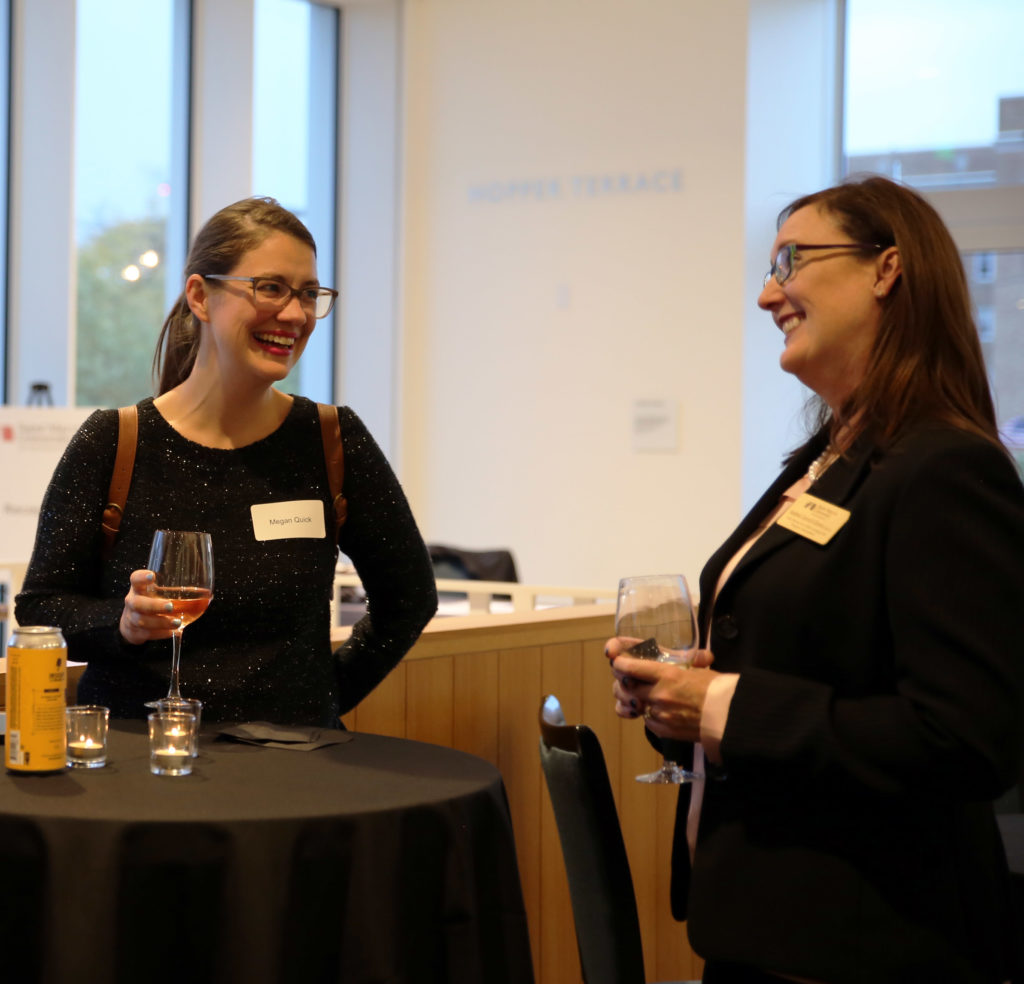
Andrea Caroll-Glover, vice provost for Online Strategy and Programs at Saint Mary’s, speaks with Megan Quick, a recent graduate of the Special Education (M.A.) program.
Hatley stood next to Jasmin Braithwaite-Hanson, a classmate who lives on the other side of the country in Mt. Vernon, N.Y., just north of the Bronx.
Braithwaite-Hanson met her husband online through a dating site, so making remote friends with people across the country was a natural progression.
“The world is only as big as we make it out to be,” she said. “The internet is just like real life to me. There’s good. There’s bad. There’s ugly — just like when you go anywhere else.”
The other women who made up the quintet were Ajibola Agboola from Rosemount, Minn.; Jean Nelson-Overn from Baldwin, Wis., and Tonya Andrews from Ames, Iowa.
“I think it’s great being able to meet the students I worked with because they gave me a level of being competitive without knowing them,” said Agboola, who added that the motivation and feedback she received from the other four students “gives you a sense of family without actually meeting your family.”
In Hatley’s case, she was in the process of trying to advance her career by applying to a new position while taking classes at Saint Mary’s. Hatley said several of her professors helped her during the interview preparation process, which ended in her accepting a job working as a project engineer for a firm that specializes in commercial construction in Alaska.
When she started looking into graduate schools, Hatley felt as if the recruiting team at Saint Mary’s were “more personable” than other programs.
“I was not only interviewing them, but they were interviewing me to see if I would be a good fit,” she said. “And I liked that. I liked that they were asking questions about what I had done just to make sure that I was ready for the program.”
Starting a new tradition
The reception was inspired by Saint Mary’s desire to further strengthen its online student and alumni communities, while also honoring students’ commitments to making the journey to meet their “virtual” classmates.
Before the reception was announced, more than 80 students had already made plans to be in Minneapolis for the commencement, said Andrea Carroll-Glover, who in August was promoted to vice provost for Online Strategy and Programs as part of the university’s commitment to the growth of its innovative online learning platforms. “Many of these students had never stepped foot in Minnesota,” she said. “We wanted to think about how we could make this special for them, celebrate their achievements, and connect them with their classmates and the university as they moved from students to alumni.
To help make the moment memorable, attendees were offered professional headshots to use in the next steps of their careers.
“We’ll learn from this and think about how we can continue to make this a special experience for our future online graduates,” said Carroll-Glover, who worked closely with a team that included Holly Tapper, director of Online Operations at Saint Mary’s; and Lisa Sanderson, associate director of Alumni Relations.
“It’s a great way for us to celebrate the accomplishments of our students as they graduate,” said Brian Schmisek, provost and dean of Faculties at Saint Mary’s. “We’re really happy to do it, and we look forward to doing it at every commencement.”
‘The stars aligned’

Attendees at the inaugural reception for online graduate students include, from left: Jessica Zielinski, recent graduate of the Learning Design and Technology (M.Ed.) program; J.C. Dahlgren, recent graduate of the Business Intelligence and Data Analytics (M.S.) program; Alan Lubowicki, spouse of Nora McGowan (far right), recent graduate of the Human Resource Management (M.A.) program.
Nora McGowan was one of those who made her first trip to Minnesota for the weekend’s events. Similar to Braithwaite-Hanson, McGowan calls the New York City metro area home. As an administrative assistant at a financial services company in Manhattan, she regularly deals with a 90-minute commute to and from her residence in northeastern New Jersey.
“Everyone is so nice. And everyone talks to you and that usually doesn’t happen in New York,” she said with a chuckle.
McGowan earned her Master of Arts in Human Resource Management by studying early in the morning, during lunch breaks, and on weekends and occasional evenings — and emailing professors who always responded quickly, she said.
“I wanted something that was all HR, not just an MBA with a few HR classes … the curriculum was great. The ranking was great. I liked that you didn’t have to attend a class at a certain time because of my commute,” said McGowan, who hopes to become an HR associate or generalist in the near future now that her degree is complete.
J.C. Dahlgren showed up to the event on his motorcycle — in spite of the fact that he came from his home in Alexandria, Va. Unlike others, Dahlgren has been to Minnesota plenty of times. He grew up in the southern metro area of the Twin Cities, before leaving town as member the Navy after graduating high school in 1996.
“I was expecting it. All this is my childhood remembered, so fortunately, I have prepared for it,” Dahlgren said about the parking lots glistening with the first traces of snow.
Dahlgren earned his Master of Science in Business Intelligence and Data Analytics after going the one-year route. After serving for nine years in the Navy, Dahlgren currently oversees IT portfolio management for the U.S. Department of Justice. He decided to earn his master’s degree from Saint Mary’s with the goal of becoming a chief science data officer for the U.S. Government.
When he was looking for an online graduate program, he remembered his roots in Minnesota — and the fact that he could not afford to initially begin his undergraduate studies after high school, leading to his decision to join the Navy. If he could, Saint Mary’s was his school of choice.
“It just so happened when I looked for Saint Mary’s, boom, there it was … the stars aligned,” Dahlgren said. “So this is 22, 23 years in the making, but I finally get to walk the halls.”
Carroll-Glover hopes to keep in contact with the new graduates as they embark on the next chapters in their careers.
“The inaugural event was a great success,” she said. “It helped to solidify a large reason why we all do what we do here at Saint Mary’s — to hear the stories of our students and celebrate their milestones, like graduation. I am excited to stay in touch as they start their next chapters in their careers and see their continued successes.”
Photo caption: Five recent graduates of the Project Management (M.S.) online program met for the first time on Oct. 11 including, from left: Jasmin Braithwaite-Hanson, Ajibola Agboola, Jean Nelson-Overn, Tonya Andrews, and Kim Hatley.

Students gain valuable experience in communication field

Welcoming Greg Zimprich ’86, center, are, from left: Derek Jackson, chair, Business Department, and Dean Beckman, chair, Department of Communication.
Saint Mary’s had the largest contingent of students of any other college at the recent Public Relations Society of America (PRSA) Minnesota Chapter PR Skill Spark event in Minneapolis on Oct. 26. Students from the Public Relations/Business Club learned from professionals about topics such as media relations, pitching stories, and job application writing tests. The students also met Greg Zimprich, a 1986 Saint Mary’s alumnus and president of the Minnesota PRSA Chapter.
Zimprich later spent two days on the Winona Campus talking to students about his public relations, journalism, and marketing career. In addition to being president of the Minnesota PRSA Chapter, Zimprich is director of finance communication at Medtronic. He previously worked at General Mills, Honeywell, and various communication firms in the Twin Cities. We are grateful to him for sharing his wealth of knowledge and experience with our students.
Photo caption: Gathering for a photo are, from left: back, Megan Prokosch, Kelly Ferguson, Dean Beckman (faculty advisor), Greg Zimprich ’86 (PRSA president), Lauryn Rogers, Brooklyn Singleton; front, Haley Graham, Maggie Heuer, Jessica Massimo, Danielle Rhodes, and Jillian Alekna.
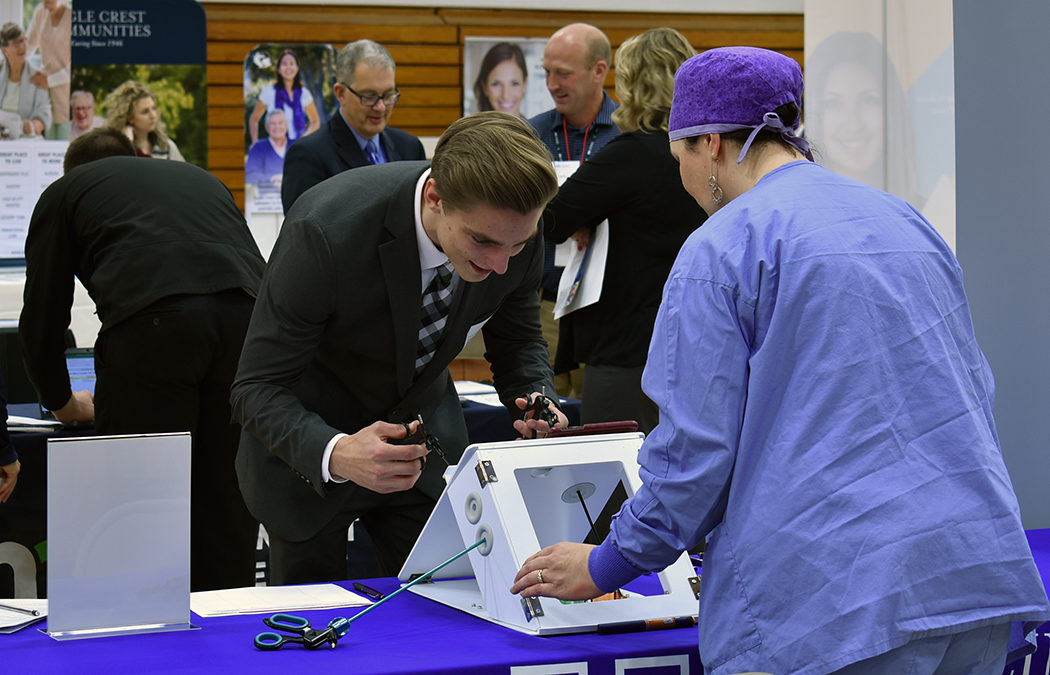
Career Services looks to expand services
In response to the challenging and ever-changing employment landscape, Saint Mary’s is assessing the role and function of Career Services to foster student and alumni success across the university. As an integral element to the Strategic Plan — Building a Future Full of Hope 2025 — Saint Mary’s is reshaping and expanding the vision, structure, and function of Career Services to enhance the university’s reputation and better prepare all our students, undergraduate and graduate, online or onground, for their future.
During the sixth annual Saint Mary’s Career and Internship Fair Oct. 23 on the Winona Campus, more than 200 students visited with more than 50 graduate schools, employers, and internship sites. Of those vendors, about 20% (15 individuals), were Saint Mary’s alumni vendor representatives on hand recruiting. Students are continuing to connect with those employers for interviews, internships, and job opportunities.
One week later, the Minnesota Colleges and Universities Career Services Association hosted a Government and Nonprofit Career Fair in the Twin Cities area. Fifty-five adult learners from the Schools of Graduate and Professional Programs registered to attend, as well as several undergraduate students from the Winona Campus.
Saint Mary’s and Career Services are also exploring ways to enhance career services to all campuses and students — as well as alumni — through increased staffing, on-site facilities, as well as expanding the use of Handshake, a leading career services web platform that is currently used on the Winona Campus. Other future expansions being discussed include virtual and online resources, as well as courses, workshops, coaching sessions, and other areas.

The Next Mission: Former U.S. Army colonel seeks to improve military transition into civilian life through dissertation research
It’s a small piece of limestone, about the size of a fist, encased behind glass.
To Col. Mitchell Brew, though, it means so much more.
Fractured in its nature, it would become a constant reminder of the time his career path in the U.S. Army would irrevocably change — and the cornerstone of the dissertation he is writing while working on his Doctorate of Business Administration (DBA) at Saint Mary’s University of Minnesota.

Col. Mitchell Brew was presented in May 2002 with this fragment from the Pentagon, along with a certificate to commemorate his service during and following the 9/11 attacks.
That’s because that limestone is a fragment from a piece of the Pentagon in Arlington, Va., that fell away from the building after the attacks on Sept. 11, 2001.
With his sights set on graduating next October, Brew is currently conducting research on the attributes and success factors of military veteran entrepreneurs — with a particular emphasis on those veterans who served after 9/11, a group almost entirely composed of volunteers who answered the call in the aftermath of the attacks.
“I believe veterans have a lot of entrepreneurial traits,” Brew said. “You have to have agility and be able to make some decisions on the fly. You’re forced to be a leader based on your role, so those kinds of traits can work really well into owning your own business.”
At the same time, Brew believes he will be able to provide insight on some of the obstacles that many veterans face when transitioning to the private sector, such as navigating cultural differences and dealing with the mismatch of military skills to civilian skills.
“His innovative work is expected to improve transition initiatives from military to civilian careers, and increase veteran entrepreneur success,” said Jennifer Schultz, Ph.D., who is serving as Brew’s doctoral advisor. “He has been able to combine his experience from the military, knowledge as a healthcare administrator, and creativity as a student to develop a research project with depth and breadth.”
Although the research is ongoing, his work is designed to support his theory, based on his initial findings, that owning a franchise of a pre-established chain of businesses represents an ideal opportunity for veterans to become successful franchisees.
“Franchising provides you that support,” Brew said. “Plus, it’s a system that has the structure that you’re used to from the military.”
‘Something much greater than himself’

Col. Mitchell Brew’s military journey started in the early ’80s (top) as a private and was promoted to colonel in 2007, the rank he would retire at.
When his dissertation is complete, Brew wants to launch a larger conversation about what is currently being done for military members as they transition to civilian life, as an addendum to the material already distributed as part of the Transition Assistance Program across all U.S. military branches.
“Mitchell cares about veterans and how they have an encore career after a whole career of service,” said Matt Nowakowski, Ed.D., the director of the DBA program who taught Brew’s capstone course earlier this semester. “He’s looking to use his experience as a colonel to give back and help other veterans. And that is something very much in alignment with our Lasalian mission. He’s doing this because he sees something much greater than himself.”
Before enrolling in the DBA program at Saint Mary’s, Brew had earned four master’s degrees through programs geared toward military personnel. As someone who claims to be “always curious,” he is thinking about one day pursuing a tenured track professorship at a business school when he finishes his doctorate.
“I’ve been to a lot of different universities… A lot of places are there for their purpose and their interest,” he said. “Here at Saint Mary’s, they’re here for that Lasallian view of taking care of people and making people advance.”
He did not know it when he enrolled in the DBA program, but that Lasallian philosophy of service fell right in line with the model of servant leadership he had used during his time in the military: Your success is based on that of your subordinates, so the leader is responsible for setting them up for success for the good of the organization.
“You get here and you find out that professors are here to set you up for success,” Brew said. “Their whole attitude is very reinforcing, very comforting. The professors all carry that same attitude. They want you to be successful.”
Around the same time he decided to start his DBA at Saint Mary’s in 2017, he accepted his current position as a strategic account executive at 3M Health Care, where he oversees the healthcare product support for more than 1,000 accounts connected to the U.S. Department of Defense and other governmental agencies.
“The people there, I know them and I understand what their pain points are and what the customer needs because I’ve been there,” Brew said, “I’m basically helping other service members and I feel like I’m contributing.”
Given that Brew frequently travels to various military bases and medical centers as part of his job, he appreciated how accommodating his professors were to the working professional while still providing a level of rigor needed for doctorate-level courses.
“I think the professors really understand our situation,” Brew said.
The day everything changed
While working as the chief for medical operations and plans for the Office of the Army Deputy Chief of Staff for Logistics, Brew was attending a meeting outside the Pentagon when American Airlines Flight 77 crashed into the western side of the building at 9:37 a.m. EST on Sept. 11, 2001, killing 184 people (both military personnel and civilians) in the process.
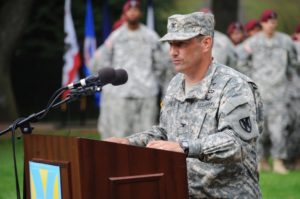
Col. Mitchell Brew speaks before hundreds of soldiers, civilians, and family members during a 10-year-anniversary 9/11 recognition ceremony in Kaiserslautern, Germany, on Sept. 9, 2011.
“They basically told everybody in D.C. to go home. As soon as I got home, I got a phone call that said ‘The Army Operations Center is going hot. Get back in here,’” Brew recalled. “So I turned around and went back. So at about 10:30, I was walking into a burning building.”
To this day, if he smells the distinct odor of dry, brittle wood, his mind will take him back to that morning.
He would stay in the building until 2 a.m. that day to help coordinate critical actions as the U.S. Army prepared its counterattack before going back for about four hours of sleep and doing it all over again. This lasted for six months. At the time, Brew was working on his MBA from George Washington University, with the idea of retiring and trying his hand in the business world after nearly 20 years of military service.

Command photo taken of Col. Mitchell Brew before he led the 32nd Medical Logistics Battalion into Iraq in 2004.
After the attacks, though, Brew felt compelled to extend his career, accepting an opportunity to guide the 32nd Medical Logistics Battalion into Iraq in 2004 upon finishing his MBA in his early 40s. He would go on to help change the way the supply chain worked in Iraq, so soldiers would have more reliable access to medical supplies.
“That’s what you live for in the Army: to lead soldiers to combat,” Brew said. “It motivated me for a higher purpose. I was very committed to doing right by my soldiers, right by our nation, right by our country. And it was a rallying cry. It helped motivate our soldiers.”
Brew earned the rank of colonel in 2007. He was then selected to command the U.S. Department of Defense’s largest medical depot: the U.S. Army Medical Materiel Center Europe (USAMMACE) in Pirmasens, Germany. He would later serve as the director of Logistics and Supply Chain Management for the Office of the Surgeon General in the U.S. Army.
His own journey
Eventually, though, Brew did retire from military service, stepping down in 2015 from his position as director of Logistics and Supply Chain Management, creating a tenure of service that he can recite without hesitation: 30 years, nine months, and one day.
He also finally dove into the corporate world, accepting the role of director of operations for Cardinal Health at its Champlain, Minn., location the same year he retired from the Army — a move that led him to the Twin Cities Campus of Saint Mary’s two years later, right around the same time he started his role at 3M.
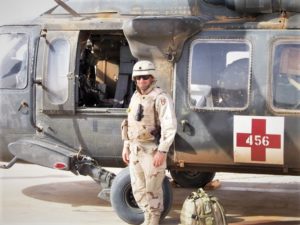
Col. Mitchell Brew stands next to a UH-60 medical evacuation helicopter in Iraq at the Al Asad Airbase in 2005.
For six months, Brew had maintained his military-grade physique by going to the gym every day and tackling projects around his house in Northern Virginia, before he decided to put his resume out into the world.
“I came up with the epiphany that, in retirement, I needed purpose. I needed something to do. I needed to contribute. I needed to feel like I’m doing something, so the retirement thing didn’t work out well,” Brew said about his own initial transition to civilian life.
After saying yes to the offer from Cardinal Health, the move to Minnesota would be the 16th for Brew and his wife, Mellissa, who is a retired lieutenant colonel after serving 24 years, six of them as a medical evacuation pilot. The two met in South Korea in the early ’90s before getting married in 1997.
Given that their oldest child of three was about to start high school, they decided they would grow roots in Minnesota. Furthermore, he made a pact with his family to not think about leaving the Twin Cities metro area — a place whose long winters can mirror those of his native Western New York town of Batavia — until their youngest child, who is in sixth grade, graduated from high school.
When Brew finished his undergraduate business degree at the State University of New York at Buffalo in 1985, he decided to jump into a military career largely due to the fact that considering the rough economic climate at the time (in his words), he could start as a management trainee at Wal-Mart for $14,000 a year or a second lieutenant in the U.S. Army for $19,000. The choice was simple, he said.
“I got into it. I just had a great time, and I really enjoyed what I do,” Brew said.
If someone is fueled by a passion such as Brew’s interest in helping fellow veterans, he recommends taking that same mentality into starting a DBA program at Saint Mary’s.
“I would say go for it. There are some things that may try to hold you back,” he said. “You may be a little scared about taking the leap, but once you get in, it’s a lot of fun.”
Shot fired near Saint Mary’s University Winona Campus Nov. 7
A shot was fired about 3:40 p.m. yesterday afternoon near Saint Mary’s University’s Winona Campus. According to the Winona Police Department, five male individuals involved remain in custody. They are not Saint Mary’s students or employees. The Winona police have also recovered the gun that was used.
According to police, the shot was fired into the air and was the result of an altercation about a drug interaction that did involve a Saint Mary’s student. No other Saint Mary’s students were targeted, and no one was injured in the incident. Notifications were sent to Winona Campus students, faculty, and staff, alerting them to the situation and letting them know there was no further danger.
Saint Mary’s administration continues to investigate this incident, and for the safety and privacy of this student, we will not release further information. Because drugs were involved, this incident is being taken very seriously.
We continue to work closely with the Winona Police Department, and the university continues to have a heightened Campus Safety presence into today for the comfort and peace of mind of the university community.
Student safety is our primary concern at Saint Mary’s, and the Office of Campus Safety continues to be a 24-hour resource for students. Additionally, guns are not permitted on any Saint Mary’s University campus, and we will continue to strictly enforce that rule.

Page Series to present singer-songwriter Leyla McCalla
WINONA, Minn. — The Page Series at Saint Mary’s University of Minnesota will present Haitian American singer-songwriter Leyla McCalla in concert at the Page Theatre on Saturday, Nov. 16, at 7:30 p.m.
McCalla’s music reflects her eclectic and diverse life experiences, projecting a respect for eloquent simplicity that is rarely achieved. Born in New York City to Haitian immigrant parents, McCalla was raised in suburban New Jersey. As a teenager, she relocated to Accra, Ghana for two years. Upon her return, she attended Smith College for a year before transferring to New York University where she studied cello performance and chamber music. Armed with Bach’s Cello Suites, McCalla moved to New Orleans to play cello on the streets of the French Quarter.
After touring with the Carolina Chocolate Drops, McCalla began to concentrate on a solo career. Her debut album, Vari-Colored Songs, a tribute to Langston Hughes, was named album of the year by both the London Times and Songlines magazine. The title of her sophomore effort, A Day for the Hunter, A Day for the Prey, was ultimately derived from a Haitian proverb. It featured songs in English, French, and Haitian Creole, with appearances by Marc Ribot, Rhiannon Giddens, Louis Michot of the Lost Bayou Ramblers, and New Orleans singer/songwriter Sarah Quintana. Earlier this year, McCalla released her third album, The Capitalist Blues.
Prior to the performance, McCalla will give a free demonstration and artist talk at 6:30 p.m. in the Performance Center’s Figliulo Recital Hall. She’ll explore her path as a musician and the impact classical music, the folk music of Haiti, and more has had on her life, work, and worldview. Tickets are not required to attend the talk.
Tickets for the performance are $27 for adults, $24 for seniors and students ages 18 and older, and $18 for youth ages 17 and younger. Tickets can be ordered online at pagetheatre.org, or by calling the Saint Mary’s Performance Center box office at 507-457-1715 (noon to 6 p.m., weekdays).
About the Page Series
Now in its 33rd season, the Page Series connects professional performing artists from around the globe with thousands of Winonans each year. With events at the Joseph Page Theatre on the Winona Campus of Saint Mary’s University of Minnesota, as well as at locations across the Winona community, the Page Series offers dance, music, and theatre performances, workshops, classes, and more that inspire, uplift, educate, and invite community members to discover the relevance of the arts in their daily lives.
This activity is made possible by the voters of Minnesota through a grant from the Minnesota State Arts Board, thanks to a legislative appropriation from the arts and cultural heritage fund.
Page Series community programs are made possible, in part, through a grant from the Xcel Energy Foundation.
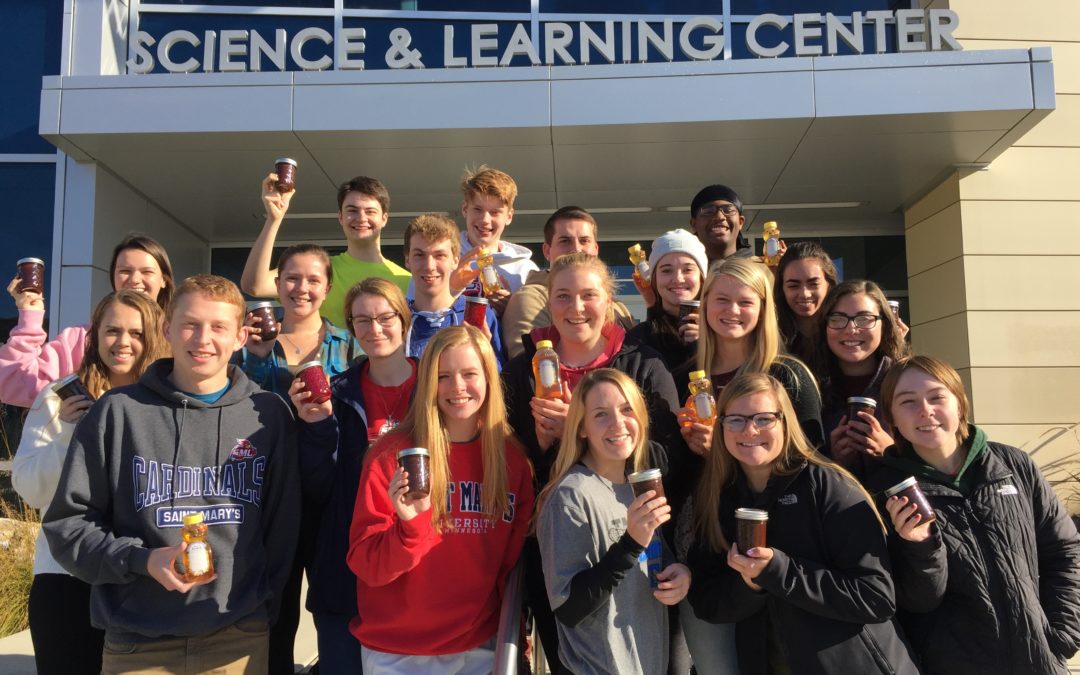
First-Year Experience course gives students new perspective on food and each other
It’s safe to say that the students in the First-Year Experience anchor course, taught by Jeanne Minnerath, Ph.D., will never look at a grocery store the same way again.
After all of their work this semester, the group of 20 students has gained a new appreciation for the food they eat.
After learning about the intricacies of the relationships between those foods and microorganisms in the classroom, the class went on to produce, process, and sell approximately 200 jars of raspberry jam, 100 jars of apple butter, 80 bottles of honey, and 60 jars of salsa — with all profits going to the food shelf at Winona Volunteer Services later in the year. The $1,800 in profit will be added to the efforts of the fall 2018 class, for a combined total of approximately $3,000, Dr. Minnerath said.
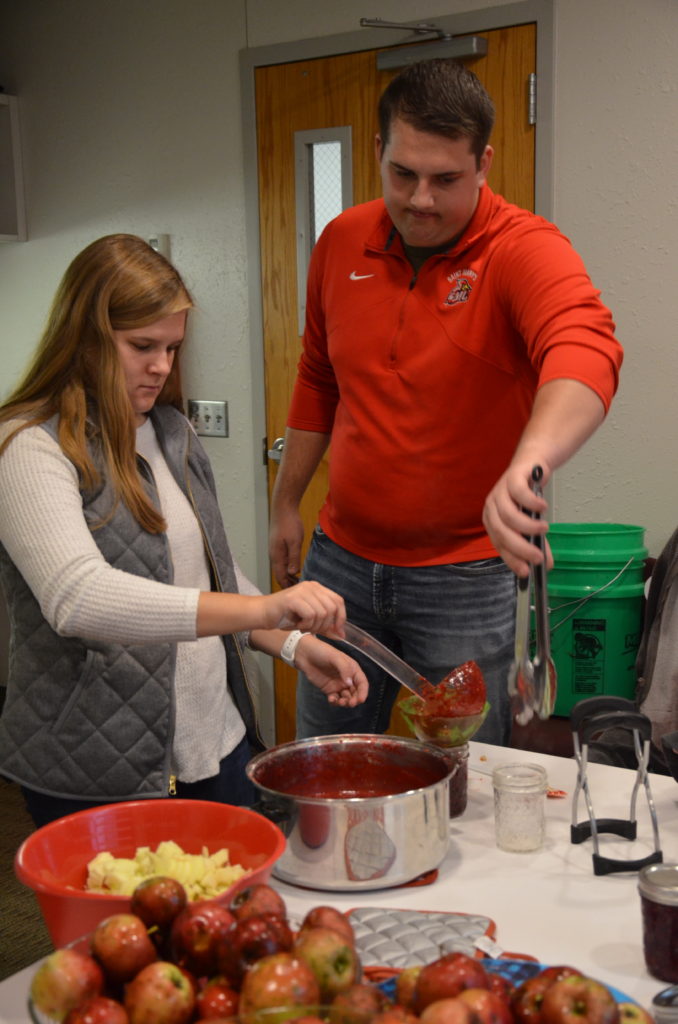
Students Alexis Pagatchnik and Sean Curran pour raspberry jam into jars. As part of the preservation process, the jars were sterilized in boiling water for 10 minutes, filled with jam, closed with lids and then processed by placing in a boiling water bath for 10 additional minutes.
A large portion of the sales is made by pushing a cart full of products around campus during Family Weekend in late September. Other sales came from faculty members.
Corinna Hafner, a first-year student from Saint Paul who is undecided on her major, said that the material covered in the class is applicable to any student, regardless of his or her major.
“We’re learning about how food and microbes go together,” Hafner said. “Everybody eats, so I think it’s cool to understand how microbes play a part in your food — how they can make you sick or how they keep you from getting sick.”
Before enrolling in the course, Hafner had previously helped her father make rhubarb jam, “but everything else was new,” she said.
One of Hafner’s favorite opportunities was helping harvest honey out of honeycomb from hives that belonged to Josh Lallaman, Ph.D., assistant professor of biology, who also happens to be Dr. Minnerath’s neighbor.
Dr. Minnerath suggested to Dr. Lallaman he could recruit students from Saint Mary’s to help him harvest the honey — and then suggested that they could sell it as part of their initiative to donate money to the local food bank.
During the process, the students had to delicately collect the honey from the honeycomb. They then put the honey through a cheesecloth to properly filter it. The students were then allowed to eat samples of the honeycomb itself once the harvesting was completed.
“Usually, you would just buy honey at the store, so you don’t know the process of making it and what goes into it, but we all got to do all of these steps,” Hafner said.
Like Hafner, Sean Curran, a first-year student from Appleton, Wis., had helped make jam before, but never had a solid grasp on the science of canning.
“Knowing how it works and why it works is what I’m going to remember,” said Curran, who is a member of the inaugural 3+2 Physician Assistant Program with Mayo Clinic School of Health Sciences. “Now I have a better understanding of not only how microbes and bacteria both help and harm us, but how we can eliminate the potential harm to us through processes such as canning.”
Where science meets food
After being tasked to create curriculum centered around environmental and human health, the course began last year as a combination of two of Dr. Minnearth’s favorite things: science (microbes and bacteria, to be exact) and food.
“I wanted to have hands-on activities in my class,” said Dr. Minnerath, who serves as an associate professor of Biology and the director of the Allied Health Program. “And so I thought, ‘OK, how can I teach them to preserve food?’”
Dr. Minnerath also wanted to cultivate a sense of community for the first-year students as they acclimate to their new surroundings. The class comes from diverse backgrounds. Some students from urban backgrounds had never been in such an environment.
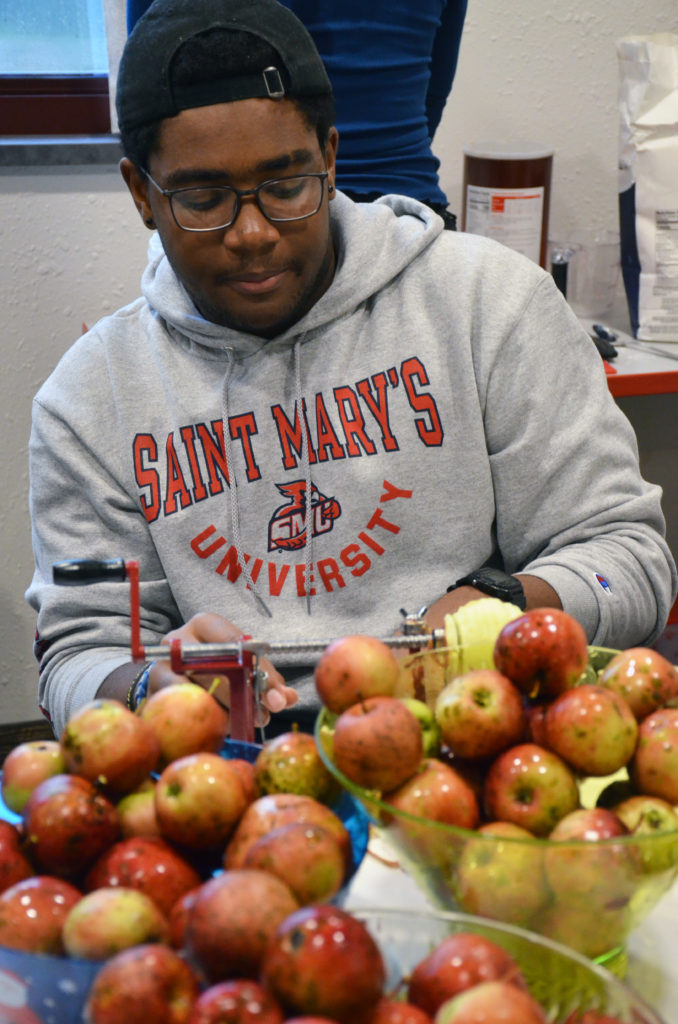
First-year student Quinton Martin, Jr., uses an apple peeler to spiralize apple slices during a recent food producing session with his First-Year Experience class.
“These are old techniques that are dying off … They have heard of canning, but they’ve never done it or seen it being done,” Dr. Minnerath said. “The goal of this class is to make the science the students learn in class relevant to their everyday life.”
As part of the preparation process, the students gathered produce from gardens on the Winona Campus — including raspberries from Brother John Grover’s famous raspberry bushes, as well as tomatoes and green peppers from the university’s garden — and from off-campus locations.
“It is important to me is that my students are getting connections to the [De La Salle] Christian Brothers. My students are finding out, ‘Wow, you can grow stuff here on this campus,’” Dr. Minnerath said.
At one point, the students gathered bruised apples to make apple butter from orchards affiliated with Father Paul Breza, the founder of the Polish Cultural Institute and Museum in Winona.
By spending so much time outside the classroom, the students have formed a bond with each other which has helped them transition to college life.
“We’ve had some opportunities to go off campus, so we’re meeting other people, but we’re also with our classmates, which has helped me to make friends,” Hafner said. “ I know everyone in my class; I study with them, I hang out with them, I sit with them during meals, which I think is really cool because it’s different than just being in a lecture and not even knowing the name of the person sitting next to you.”
Give to the Max and benefit Saint Mary’s
 Saint Mary’s University of Minnesota will once again be participating in Give to the Max Day, held this year on Thursday, Nov. 14. This 24-hour giving challenge is coordinated by a nonprofit called GiveMN, which focuses on connecting generous donors (from anywhere) with Minnesota-based charities or nonprofits.
Saint Mary’s University of Minnesota will once again be participating in Give to the Max Day, held this year on Thursday, Nov. 14. This 24-hour giving challenge is coordinated by a nonprofit called GiveMN, which focuses on connecting generous donors (from anywhere) with Minnesota-based charities or nonprofits.
One of the benefits of participating in this fundraising event is the chance to win additional prize dollars for Saint Mary’s. GiveMN has secured more than $100,000 in prize money for participating organizations to be given away in increments ranging from $500 to $10,000 as often as every 15 minutes on Give to the Max Day. Prizes are also given daily during “early giving,” the time period between Friday, Nov. 1, and Wednesday, Nov. 13, so participation can begin now; however, only gifts made through GiveMN.org during this time qualify for inclusion in all prize drawings.
Prizes are awarded by randomly selecting a donation made during certain times and awarding the prize amount to the organization that donor selected for that gift. The more donations Saint Mary’s receives, the better the chance of being able to win extra prize dollars. The 2019 prize pool is as follows:
- $500 Golden Tickets every 15 minutes
GiveMN will award $500 Golden Tickets every 15 minutes on Give to the Max Day.
- $6,000 Power Hours at 10 a.m. and 10 p.m.
GiveMN will award a total of $6,000 among the top three organizations who raise the most money between 10 to 10:59 a.m. and 10 to 10:59 p.m. First place will receive $3,000; second place will receive $2,000; and third place will receive $1,000.
- $1,000 Hourly Golden Tickets
At the end of each hour on Give to the Max Day, GiveMN will randomly draw a donation from that hour and add $1,000 to the total.
- $500 Early Giving Golden Tickets
Give to the Max Day Early Giving takes place from Friday, Nov. 1, to Wednesday, Nov. 13. GiveMN will randomly select one donation from each of these days to receive a $500 Early Giving Golden Ticket.
- $10,000 Super-Sized Golden Ticket
The $10,000 Super-Sized Golden Ticket will be drawn at the end of Give to the Max Day from all donations made between Friday, Nov. 1, and Friday, Nov. 14.
Gifts made to Saint Mary’s on Give to the Max Day will primarily support the Saint Mary’s Fund, which is a key resource for helping students and academic programs, providing funding that can immediately support a variety of needs. Donors can also choose to support the Cardinal Excellence Fund for Athletics and the First Generation Initiative.
Find more information and the giving portal at givemn.org/organization/smumn. You can also contact Tracy Heaser in Advancement and Communication at theaser@smumn.edu or by calling 507-457-1791.
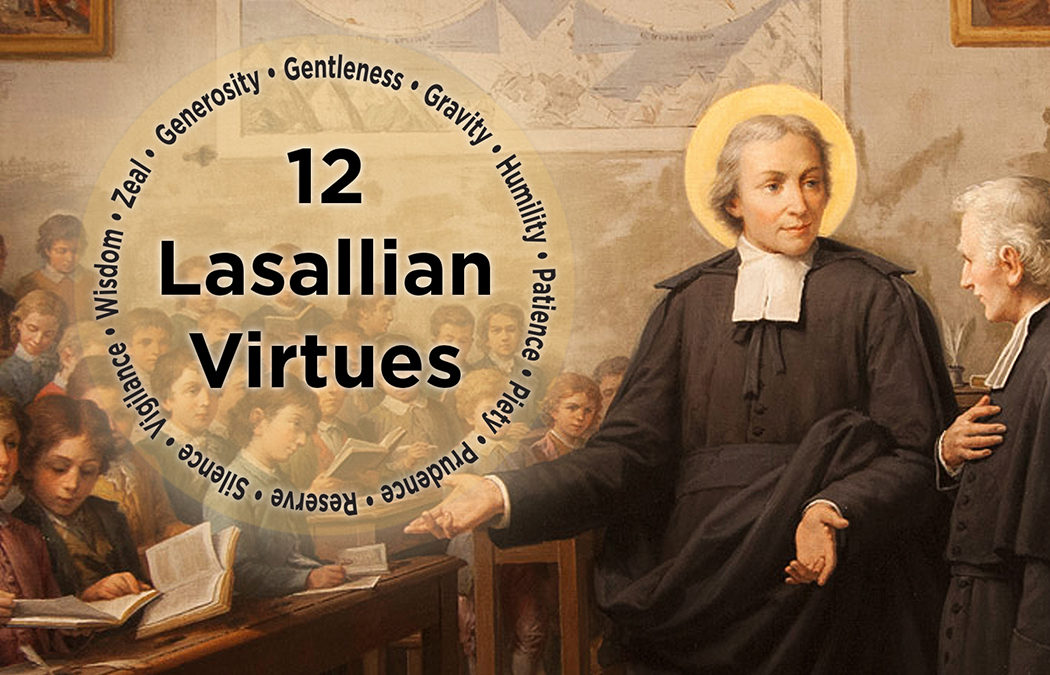
Lilly Fellows grant to allow committee to develop rubric for 12 Lasallian virtues
They are intrinsically connected with the foundation of Lasallian education, but what impact do the “12 Virtues of a Good Teacher” have on today’s educators and students? Are there virtues that are missing or less relevant in modern-day teaching practices?
Those were the questions formally posed by a trio from the Winona Campus of Saint Mary’s University of Minnesota.
Luckily, after being rewarded a Lilly Fellows Small Grant, those three team members will be one step closer to discovering answers with the construction and promotion of a Lasallian teaching rubric — and related materials — on the 12 virtues.
“It’s something that I believe is new to many new faculty here, especially those who do not come from another Lasallian institution. It’s something that we are introduced to, but is not really elaborated upon much,” said Christopher Bobier, Ph.D., assistant professor of Philosophy.
Before arriving on the Winona Campus in the fall of 2018, Dr. Bobier was not aware of the 12 virtues first written by Saint John Baptist de La Salle in 1706 and reissued by Brother Agathon, FSC, the fifth Superior General of the Brothers of the Christian Schools.
The 12 virtues are:
- Generosity
- Gentleness
- Gravity
- Humility
- Patience
- Piety
- Prudence
- Reserve
- Silence
- Vigilance
- Wisdom
- Zeal
Personally, Dr. Bobier said he could relate the most, based on his disposition, to the virtues of gentleness and generosity within the parameters of the classroom. He struggled, though, with the virtue of silence in particular.
“We want our students engaged,” he said. “When they’re quiet and don’t answer questions, we naturally interpret that as they’re not following along or they’re not engaged and therefore, I’m not doing my job well. Whereas to Saint John Baptist de La Salle — and more specifically Brother Agathon — silence is one of those tools that we can use to promote reflection among students.”
Knowing the university’s history of successful recipients of the grant, Dr. Bobier enlisted the help of Joseph Tadie, Ph.D., associate professor of Philosophy, and Adam Potthast, Ph.D., director of Assessment and Faculty Development who also runs the Center for Excellence in Learning and Teaching.
The initiative will begin in the fall 2020 with the formation of a seven-member committee comprising Drs. Bobier, Potthast, and Tadie, as well as four other senior faculty members. The committee will meet every other week to discuss readings on the 12 virtues, Lasallian pedagogy, and best teaching practices — and how they compare or contrast with modern-day teaching research. If all goes as planned, the findings from the committee will be posted on the center’s website as a resource for all faculty on the three campuses that compose the Saint Mary’s academic community.
“It also serves as an opportunity not just for new faculty to see what’s expected of them in the classroom, but having one resource — we hope — will help get deans, department chairs, and administrators on the same page with regard to Lasallian pedagogy,” Dr. Bobier added.
The Lilly Fellows Program in Humanities and the Arts began at Valparaiso University to “stimulate conversation about church-related higher education and church-related mission on their campuses or among church-related institutions in close proximity to each other.” Only new programs are funded in the amount of $1,500 to $3,000. The total amount requested in the proposal was $2,850 to cover all projected expenses.



